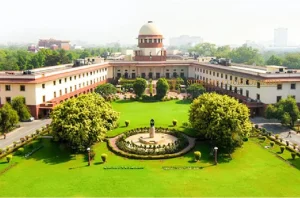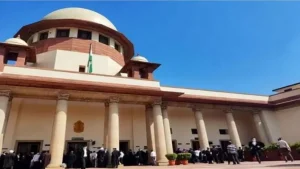

Administration of Justice – Legislative Power of Reform (Part II)
- /
- Articles and Blogposts /
- Administration of Justice – Legislative Power of Reform (Part II)
Introduction
Entry 11A of the concurrent list gives both the state and the union legislatures power to legislate on administration of justice. This power has been used to establish new courts and vest them with jurisdictions. Moreover, Articles 323A and 323B of the constitution allow the Parliament to establish tribunals for adjudication of disputes relating to a number of areas. However, the breadth of the phrase ‘administration of justice’ cannot be limited only to establishing courts and tribunals. As discussed in the last blog, popular understanding and the court’s own interpretation of the words suggest administration of justice is a nebulous term that encompasses every activity involved in adjudication as well as judicial administration. Applying a similar understanding to Entry 11A of concurrent list would mean vesting the legislatures with enormous powers over the judicial process. This becomes significant in the context of judicial reforms.
However, such broad power of the legislature over the judicial process is not permissible, both from a separation of power perspective and for independence of judiciary – a feature that has been read into the basic structure of the constitution. Despite these constraints, as representatives of the people, the legislature and consequently the executive are legitimate stakeholders in the question of reforming the judicial processes. Thus, to what extent the power to legislate on administration of justice can be used in designing more efficient courts is a question that merits investigation. This is the aim of this blog post. It looks at the clashes between the parliament and the judiciary to see how the judiciary responded to attempts at reform from the parliament to determine how the power under entry 11A can be exercised respecting judicial independence and separation of powers.
Independence of the Judiciary and Separation of Powers
The doctrine of separation of powers believes that the power of the government can be classified into three categories – the executive, the legislature and the judiciary. A necessary corollary to this doctrine is the need for each branch to be relatively independent from the other. The personnel of each branch are distinct and each branch decides its own manner of function. However, it does not follow from this doctrine that attempts at judicial reforms should be only from within the judiciary. A study of cases involving judicial independence will show that the concern has always been with executive control over the judges and not legislative creation of new institutions.
The most noted site of conflict between the executive and the judiciary with respect to separation of powers has been on the question of judicial appointments. The second judges case [1] famously held that consultation with the Chief Justice of India requires concurrence of opinion and judicial primacy is required in the process of appointing judges. The third judges case[2] formally institutionalised the collegium system – all in the name of judicial independence. When the 99th Constitutional Amendment was struck down for violating the basic structure of the constitution, it was also with the reasoning that equal number of judges and members appointed by the executive does not guarantee primacy of judiciary in the appointment of judges [3].
Even in the four Madras Bar Association cases relating to establishment of tribunals to reform the legal system, one of the main points of contention was the composition of the search-cum-selection committees. The proposed composition would include the chief justice of India, the chairperson of the tribunal and three secretaries from different departments thus tilting the balance in favour of the executive. In Madras Bar Association II [4], this was struck down for violating the judicial independence and the number of secretaries was reduced to two with the CJI having a casting vote. Thus, in both the cases of tribunals and appointment of judges, judicial independence was located in judicial primacy in appointments. Similarly, judges can be transferred only at the behest of the CJI Another factor was competence of the appointees. The court held that judicial independence can be ensured if competent people are appointed into tribunals and changed the selection criteria accordingly.
Another restriction against broad use of the power to legislate on administration of justice lies in Articles 145, 146, and 229 that allow the Supreme Court and the High Court to determine the remuneration, qualifications and terms of employment and conditions of service of the officers of the courts. There has been considerable back and forth to determine the respective powers of the judiciary and the executive with the court once holding that the decision of the judiciary is absolute. However, in more recent cases the court has held that the president’s consent is not a mere stamp of approval but vests him real power. In any case, this power is subject to any law made by the parliament. Similarly, the power to regulate the process of the court under Article 145 is also subject to any law made by the parliament.
The most difficult constraint is, however, Article 227 which gives the High Court the power of superintendence over subordinate courts. It has been held that this power can be used for judicial as well as administrative oversight.[5] There are a series of cases on interpreting this power which are mostly concerned with the judicial aspect.[6] These cases hold that Article
227 can be used to interfere with the proceedings of the lower courts when the violate fundamental principles of law or exceed their jurisdiction.[7] In case of administrative superintendence, the power is used to discipline the subordinate courts and issue guidelines for their functioning. This power has been used most recently for formulating the guidelines for virtual hearings. This power of the High Court is not subject to any law made by the Parliament meaning that the parliament cannot abrogate the power of high court in its attempts at reforming the working of subordinate courts. However, it only means that the parliament is to share its power with the High Court and does not indicate that the High Court is at a higher footing, as long as the other principles of separation of powers discussed are respected. As long as the High Court is granted the power of oversight, the legislature can, of course, draft laws guiding the power of oversight without taking on itself the responsibility of superintendence. In other words, the parliament may make laws regulating the procedure of the subordinate courts while leaving it to the High Courts to implement them. This is not an unusual argument as this is exactly how procedural laws like the CPC and CrPC work.
The role of the Legislature
The above discussion on cases involving judicial independence and separation of powers show that the concern of the judiciary has mostly been possible executive control over the judges. This apprehension has played out in striking down legislative attempts at reforming judicial appointments as well rules relating to tribunals. The idea of judicial independence has most often been located in judicial primacy in appointments lest judges be “indebted” to the executive. [8] Similarly, the concern has been regarding management of the judicial process, but again with respect to transfer of judges. In other cases, like in determining the conditions of service of officers of the court, the role of the executive has been recognised. Even in the conflicts over tribunals, the concern has been appointment and qualification its members.
However, judicial reforms are not all about appointment of judges. Most attempts at reforming the legal system are concerned with redesigning the system, creating infrastructures and improving institutions so as to improve efficiency. The concerns of executive encroachment come in at the stage of managing the institutions so created. Nothing stops the parliament from redesigning the institutions and creating the infrastructure and then let the judiciary manage themselves. Even the Supreme Court power to regulate its own process is subject to laws enacted by the parliament. The parliament always has the power, for example, to create infrastructure for alternative dispute resolutions mechanisms and make mediation mandatory in certain cases. It can redesign our legal system by creating new courts of appeal and equip them with technology. Separation of powers does not become a concern.
Conclusion
Different commentators have claimed that judicial reforms should stem from within the judiciary. The court has indeed taken up this task by establishment of the e-courts committee among others. However, putting the burden of reforms entirely on the judiciary will be excusing the legislature from its role as representatives of people. In any case, overburdened judges may not be the best people to devise new processes and design new institutions. While the question of judicial independence may be a legitimate concern, it does not arise when the legislature concerns itself only with creation of new processes and infrastructure which is the most important task. The problem arises only when the legislature vests the control of the institution to the executive as seen in the cases discussed in this post. As long as the control of the institutions is with the judiciary, separation of powers will not be violated. There is no reason that legal system reforms should be left entirely to the judiciary, especially when the constitution grants such broad powers to both the union and the state legislatures.
Endnotes:
[1] Supreme Court Advocates-on-Record Association v Union of India, (1993) 4 SCC 441
[2] Re Special Reference No 1 of 1998, (1998) 7 SCC 739
[3] Supreme Court Advocates-on-Record Association v Union of India, 2015 SCC Online SC 964
[4] Madras Bar Association II (2015) 8 SCC 583
[5] Waryam Singh v Amarnath 1954 SCR 565
[6] Ram Roop and Ors. vs Bishwa Nath and Ors. AIR 1958 All 456
[7] Supra at [6]
[8] Supra at [3]
Debditya Saha is an intern with DAKSH.

Debditya Saha
RECENT ARTICLES


Lessons for Judiciary from Space Sector

The missing piece in India’s reform story—a strong tribunal system

Fast-track courts may not be the cure

-
Rule of Law ProjectRule of Law Project
-
Access to Justice SurveyAccess to Justice Survey
-
BlogBlog
-
Contact UsContact Us
-
Statistics and ReportsStatistics and Reports
© 2021 DAKSH India. All rights reserved
Powered by Oy Media Solutions
Designed by GGWP Design